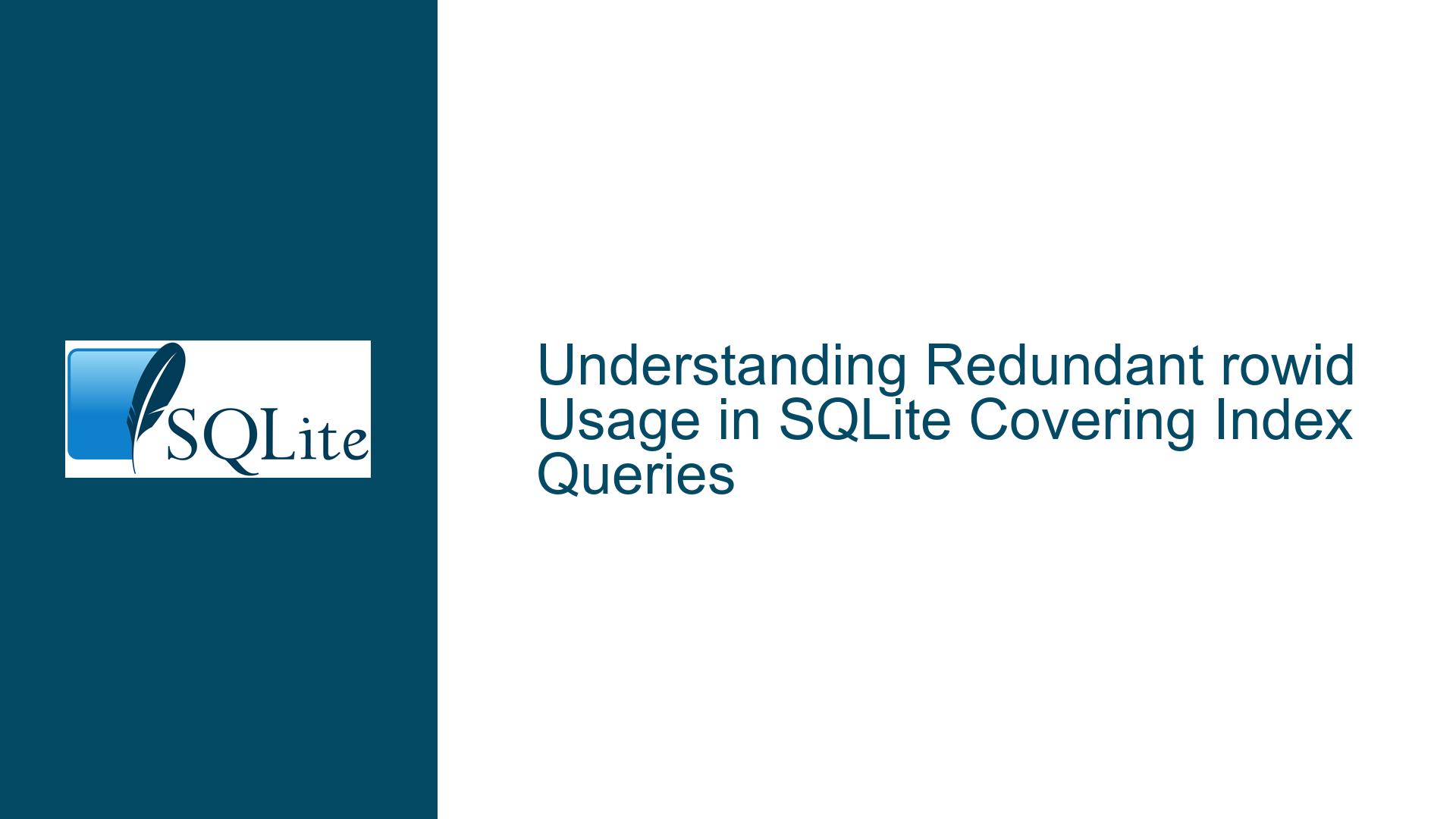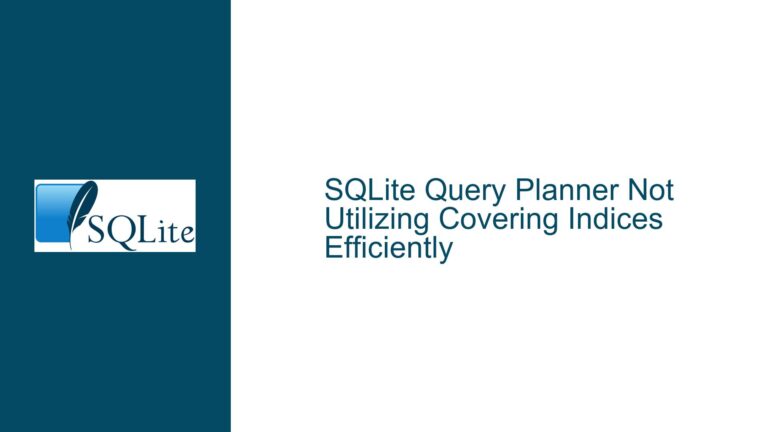Redundant rowid Usage in SQLite Covering Index Queries
Index Structure and rowid Relationship in Covering Index Scenarios
Issue Overview
When working with SQLite, developers often leverage covering indexes to optimize query performance by eliminating unnecessary table lookups. A common point of confusion arises when the rowid column appears unexpectedly in query plans, even when an indexed column explicitly aliases rowid. This occurs specifically in tables where an INTEGER PRIMARY KEY column (which is an alias for rowid) is part of a composite index. For example, given a table urls with a primary key url_id (aliasing rowid) and a composite index on (url_id, type_id), the EXPLAIN QUERY PLAN output may include a redundant-seeming rowid=? condition when using the index. This behavior stems from SQLite’s internal handling of indexes, the relationship between rowid and its aliases, and the structure of B-tree indexes. Understanding why rowid appears in this context requires a deep dive into SQLite’s storage mechanics, index design, and query optimization strategies.
Root Causes of Redundant rowid Conditions
The presence of rowid in the query plan for a covering index that includes an INTEGER PRIMARY KEY column arises from three interrelated factors:
Index Entry Composition: Every SQLite index entry implicitly includes the
rowidof the corresponding table row as the final component of the index key. This is true even when the indexed columns include therow_idalias (e.g.,url_idin this case). When an index is created on(url_id, type_id), the actual stored keys are(url_id, type_id, rowid), despiteurl_idbeing equivalent torowid. This redundancy is an artifact of SQLite’s B-tree index design, which requires a unique identifier for the table row.Query Planner Output Interpretation: The
EXPLAIN QUERY PLANoutput reflects the internal steps taken by SQLite’s query planner. When a covering index is used, the planner may still referencerowidin its output because the index itself contains therowidvalue. This does not imply a performance penalty or redundant computation; it is a side effect of how the planner describes index scans.Column Aliasing and Optimization: While
url_idandrowidare logically equivalent, SQLite treats them as distinct entities at the storage layer. The query planner recognizes the equivalence during optimization but may still display both in the query plan for clarity, especially when debugging or tracing index usage.
Resolving Redundant rowid References in Query Plans
To address confusion around rowid appearing in covering index scans, follow these steps:
Step 1: Validate Index Structure
Confirm the implicit inclusion of rowid in the index by inspecting the index’s underlying structure. Use the sqlite3_analyzer tool or execute a debug-mode query to observe the full index key composition. For the index my_index, the stored keys are (url_id, type_id, rowid), even though url_id is an alias for rowid. This structural detail explains why rowid appears in the query plan.
Step 2: Analyze the Query and Schema
Review the query triggering the plan. If the query includes a WHERE clause with url_id and type_id, the planner will use my_index to resolve these conditions. The rowid condition in the plan is not an additional filter but a reflection of the index’s stored rowid value. Since the index covers all columns required by the query, no table lookup occurs, and the rowid reference is purely informational.
Step 3: Test with Simplified Queries
Isolate the issue by running minimal queries. For example:
EXPLAIN QUERY PLAN SELECT url_id, type_id FROM urls WHERE url_id = 1 AND type_id = 2;
Observe whether the plan still includes rowid=?. If it does, this confirms the behavior is inherent to the index structure, not the query logic.
Step 4: Compare Against WITHOUT ROWID Tables
To see how rowid behavior changes, create a WITHOUT ROWID version of the table:
CREATE TABLE urls_norowid (
url_id INTEGER PRIMARY KEY,
url TEXT NOT NULL UNIQUE,
type_id INTEGER NOT NULL
) WITHOUT ROWID;
CREATE INDEX norowid_index ON urls_norowid (url_id, type_id);
Run the same query and compare the plan. The rowid reference will disappear because the primary key is stored explicitly, eliminating the implicit rowid column. This demonstrates how rowid aliasing affects index behavior.
Step 5: Leverage SQLite Internals Documentation
Consult SQLite’s documentation on index key formats and covering indexes. These resources clarify that indexes always include the rowid (or primary key for WITHOUT ROWID tables) as the final key component, which aligns with the observed query plan behavior.
Final Recommendations
- Ignore Redundant rowid References: If the query performs optimally, the
rowidin the plan is harmless and reflects SQLite’s internal mechanics. - Use EXPLAIN for Deeper Insights: Run
EXPLAIN(not justEXPLAIN QUERY PLAN) to see bytecode-level operations, confirming that no redundant comparisons occur. - Consider Schema Redesign: If
rowid-related confusion persists, switch toWITHOUT ROWIDtables where the primary key is stored explicitly, eliminatingrowidaliasing side effects.
By systematically analyzing index structures, query plans, and SQLite’s storage model, developers can demystify seemingly redundant rowid references and optimize their schemas accordingly.






